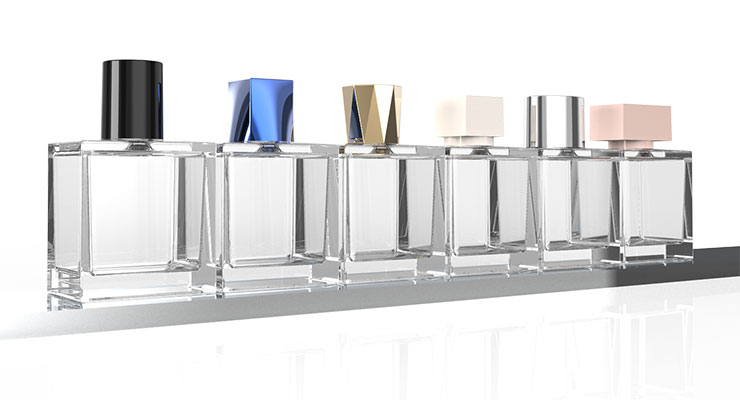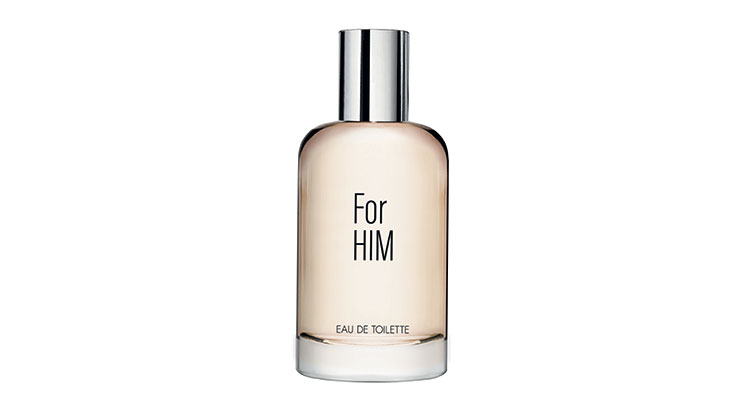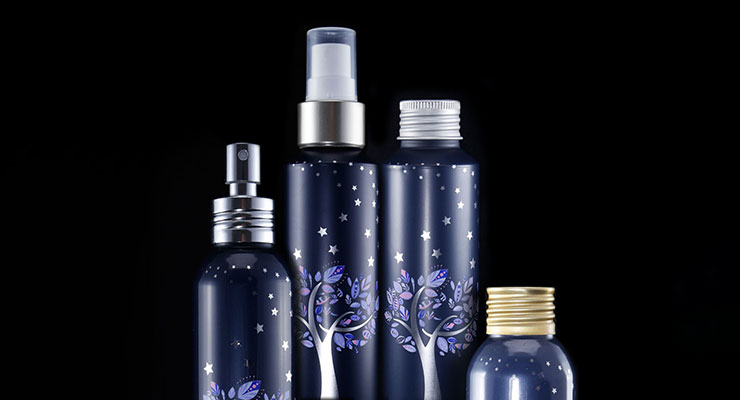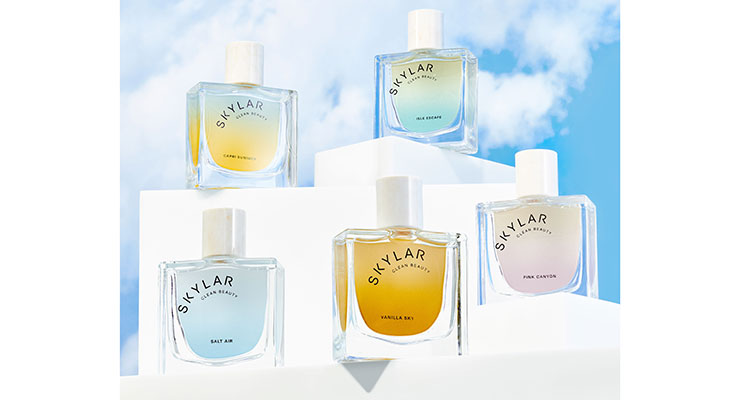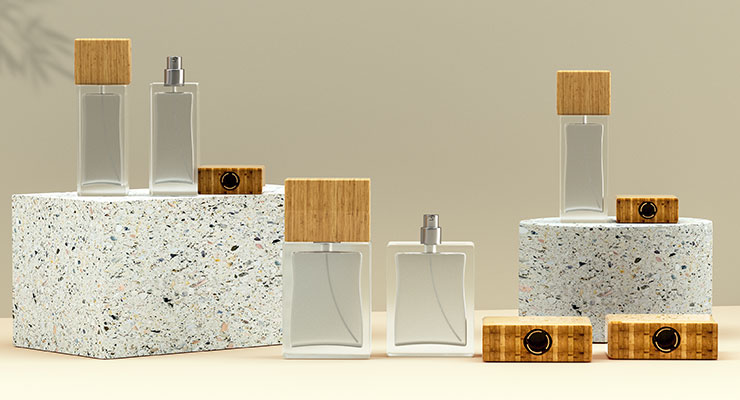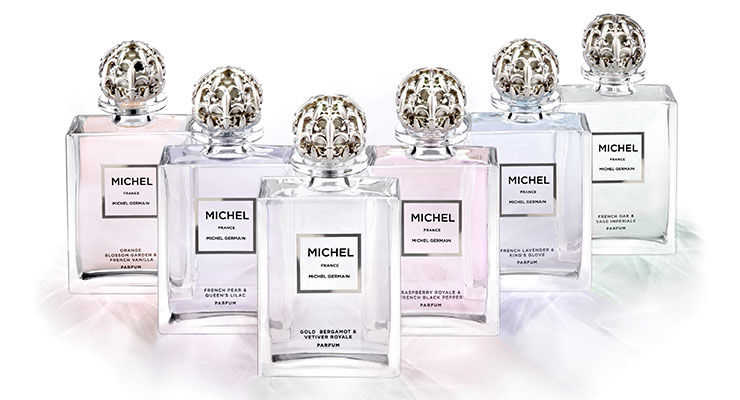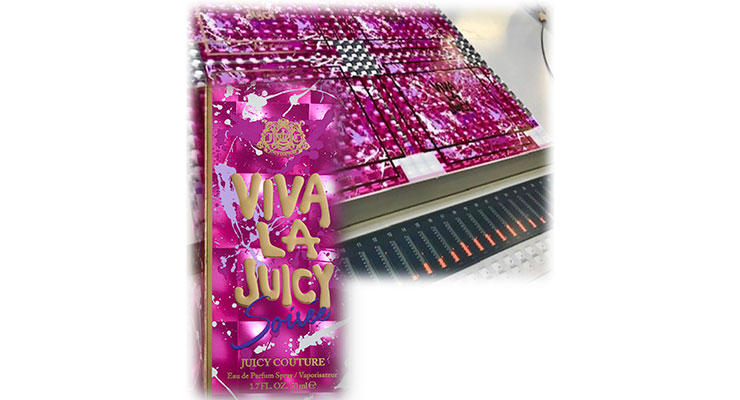Marie Redding, Senior Editor02.03.22
Glass perfume bottles with sculptural curves, precisely molded corners, or glistening facets help lure consumers—but the most successful designs are connected to the juice, experts say.
Package designers often go to great lengths to ensure the consumer can “smell” what’s inside a bottle with their eyes.
“That’s visual communication,” says Marc Rosen of Marc Rosen Associates—and a member of Beauty Packaging’s Board of Advisors.
“The bottle is the silent salesman. The consumer sees it in an ad, online or on counter and it needs to speak to them so they think, ‘I want to touch that.”Rosen is known for mentoring fragrance packaging design students and raising funds for Pratt University's Scholarship Fund at his annual Art of Packaging Gala.
--Marc Rosen
Rosen describes how to accomplish this:
“If the edges look sharp in the glass, it has to feel sharp or the customer is disappointed and will put it down. If a bottle looks rounded and sinuous, it has to feel sexy when they pick it up. That’s what will make the customer want to smell it.”
Pair an elegant bottle with a luxurious cap, and consumers are even more enticed to try a spritz, marketers hope.
And the carton isn’t just an afterthought—it’s where every fragrance’s story begins.
“The carton that encloses a fragrance bottle is the very first part of the packaging that the consumer touches at home,” says Mitchell Kaneff, CEO, Arkay. “It’s your customer’s first interaction with your brand, so it’s an emotional connection—that has to be made in a fraction of a second.”
So how can a fragrance marketer use packaging to connect with consumers—and entice them to make a purchase?
Get all the details right, experts advise—and partner with the right packaging suppliers.Every aspect of a fragrance package must be in sync, from the bottle, cap and pump to the carton.
Here, several of the foremost packaging suppliers in the fragrance industry describe their latest offerings—with a focus on sustainability.
Discussing Glass
Without glass, some of the most beautiful fragrance bottles in the world wouldn’t exist.Although glass is traditionally an eco-friendly material, a package’s overall sustainability always depends on various factors. “There is no more sustainable component than glass,” says John Schofield, owner, vice president of sales and marketing, Screentech.
Decoration affects recyclability
“Our decoration techniques for spraying and printing on glass are organic, with few exceptions,” Schofield says, explaining that the inks they use are fully recyclable. Screentech’s expertise lies in decorating glass using spray techniques, hot-stamping, screen printing, tampo printing and labeling.Screentech offers a spray process that allows for the spray coating of up to five colors in a single pass, and its customers say there’s no match for its hot-stamping-on-glass capabilities. “We are much sought after because of our color-matching ability, and we do this in-house, so it’s a quicker turnaround time, which offers brands more flexibility,” he explains.
Zignago, which has two divisions, Zignago Vetro and Zignago Brosse, has over a century of glassmaking experience. “Glass is 100% recyclable and lasts for an infinite number of uses,” says Kelly Gardi, vice president of sales & marketing, Zignago Glass USA.
Zignago Glass USA offers a wide range of sustainable, eco-friendly stock glass solutions.
“We implement the latest innovations to our production processes to enhance glass quality and bottle shapes,” says Gardi. “Our R&D team researches and tests new decoration techniques to respond to the fragrance market’s rapidly changing needs.”
A glass-making technique called 'Up & Down'
Zignago’s latest innovative, patented glassmaking technique is called ‘Up and Down.’ “It enables bottles to be produced with thicker glass in the shoulder area and an impressive base glass distribution,” explains Gardi.As for decoration, the supplier offers a stock collection and in-house custom decoration. Company capabilities include spraying, silk-screening, pad printing, hot stamping, sublimation, sandblasting, internal spraying and more.
Glass may be luxurious—but it’s also heavy, a disadvantage for sustainability and carbon footprint.
Lightweighting keeps a bottle’s luxe design intact while reducing the amount of materials required to produce it. “Many of our customers trust us to help reduce glass weight by up to 60%,” says Michel Levisse, vice president of sales, marketing & product development, Verescence. “The capacity of the glass bottle does not change—nor the luxurious feel.”Bormioli Luigi produces bottles for the beauty industry in two of its factories in Italy, and the supplier says these are among the most sustainable manufacturing sites in the world. Its production process reduces waste, as well as water and energy use.
Still, glass production is extremely energy-demanding. Simone Baratta, beauty business unit director, Bormioli Luigi, spoke to us about the challenges that glassmakers are facing. “We are worried. With the current energy crises, production costs are much higher,” he explains.
Since the pandemic began, ongoing supply chain issues have affected the delivery of all the necessary materials and components for the fragrance packaging industry. On a positive note and despite challenges, Baratta says the company still provides a reasonably short lead time. “I am proud of our team’s ability to maintain a good level of agility and reactivity,” he says.
Baratta says the team at Bormioli Luigi has been hard at work developing new innovative designs. “Innovation and sustainability are very much connected today. Our latest technologies focus on refillable designs and ultra-light glass. We will also offer bottles with interchangeable screw necks,” he says.
Are Refillable Designs the Future of Fragrance?
Refillable perfume bottles are increasingly popular. “Glass portrays the look of luxury to perfection—and refillables are an excellent option for sustainability,” says Gilda Mirra Cutri, vice president of operations & business development, Coverpla.Julie Vergnion, marketing & communication manager, Axilone, also says refillable designs combine the best of both worlds—sustainability and luxury. “Ultra-premium refillable packs are like a jewel to be kept,” she says.
John Shen, CEO, APR Beauty Group, also agrees and explains, “Refillable options maintain a luxury feel, while refill cartridges require minimal materials—this is the future of packaging.” APR Beauty offers various eco-friendly solutions that address a variety of sustainability metrics. Options include light weighting, bio-based materials, and mono-materials.
The supplier also developed an elegant solution for glass sprayer vials. “They’re lightweight but are often perceived as low-end and fragile,” says Shen. The supplier’s solution is a customizable, refillable PET case.
“Our case not only holds and protects the glass fragrance vial, but also has a unique ‘bottom twist’ feature,” explains Shen. “It works by raising or lowering the inner vial for actuator accessibility. With this case and innovative feature, there’s no overcap required. And no breakage or accidental actuation,” he says.
ABA Packaging is another supplier to turn to for refillable packaging. The supplier offers a large variety of glass and aluminum bottles with threaded necks—the feature that makes them refillable. “Our bottles pair with our large variety of threaded fine mist spray pumps,” says Michael Warford, director, business development, ABA Packaging.
ABA offers a wide selection of glass fragrance bottle standards, since the company represents most of the world’s major fragrance glass manufacturers. “We also maintain shelf stock in our New York warehouse for some of our most popular bottles for quick delivery,” Warford says. “We sell those by the case or by the thousands.”
Zignago is another supplier with numerous refillable options. Zignago offers a wide range of refillable screw neck bottles, and they are available as stock packages.
Bormioli Luigi’s Barratta also comments on refillable bottles, agreeing that they will play a larger role in fragrance’s future. “Refillable designs are the strongest trend today—so the screw neck bottle is dominant right now,” he says.
And if a fragrance brand isn’t marketing a perfume as refillable and they’re not selling refills, there is still a reason for using a bottle with a threaded neck. This feature makes it easy for consumers to separate the plastic pump from the glass bottle. This is what Skylar Clean Beauty has done—read on.
Designed for Disassembly
One way to ensure a glass bottle is more eco-friendly is to think about its end-of-life, and that’s what the team at Skylar Clean Beauty is doing. Skylar’s bottle is ‘designed for disassembly’—consumers can easily unscrew the pump before recycling the bottle and cap separately.The brand collaborated with Coverpla to launch the packaging for its fragrance line. The bottle features an organic inner shape that “intends to mimic the shape of a cloud,” the brand states.
The juice is suspended in its circular inner bottle, surrounded by an outer rectangular thick-walled bottle. “The design’s organic internal vessel and debossed outer shape were a challenge to produce,” says Cutri. “Making sure the internal organic shape looks identical in every bottle is a complex process. The factory was able to achieve the brand’s vision after a few trials—and on time to make the launch,” she says.
Skylar uses the same bottle for all its fragrances, including Vanilla Sky, Salt Air, Coconut Grove, Pink Canyon, Fall Cashmere, Capri Summer, Isle Escape, Sun Shower, Magic Bloom and Willow Woods. The California-based company also makes candles in the same scents. ‘Clean scent formulation’ is its mission, and its fragrances are all hypoallergenic.
New High Glass also offers a pump spray that is ‘designed for disassembly.’ “We added a screw-off perfume sprayer to our line of in-stock components, and it fits almost all of our bottles,” says Dave Desai, vice president of sales & marketing, New High Glass.
“We also intend to expand our color range for this line, and are developing new designs that we will introduce in the second half of 2022,” says Desai.
Removing the pump is a step in the right direction, but will all pump sprayers be recyclable soon?
“The dispensing industry is moving toward mono-material pumps,” says ABA’s Warford. A new 100% recyclable mono-material pump was introduced last year.
PCR Glass
Packaging suppliers are offering glass innovations ideal for a fragrance brand’s sustainability story. Zignago worked with Issey Miyake Parfums to produce the bottle for Drop d’Issey, which launched last year. The bottle is made using 5% post-consumer recycled (PCR) glass.Drop d’Issey Eau de Parfum is in an elegant round bottle, inspired by a water droplet—and it lies flat. Todd Bracher designed the bottle, and stated it is meant to be “cupped in the hand.” The design also requires less materials to produce.
The “drop-in-drop” design conveys a visual effect similar to a magnifying glass. The team at Zignago Brosse overcame multiple technical issues when producing this challenging design. Production was adapted to meet the brand’s specified glass weight. The glassmaker also had to ensure a perfect fit between the bottle and the spray cap, due to the bottle’s high shoulders.
Zignago offers PCR glass as part of its stock collection. “We have created a stock collection of bottles with 60% post-consumer recycled glass, and these are available for both small and large quantity orders,” explains Gardi. Zignago owns three glass recycling facilities in Italy—plus an electricity plant, Zignago Power, which generates electricity from renewable sources of energy. “The electricity from Zignago Power is used for our production facility in Venice,” says Gardi.
Verescence now offers “Verri Infini 20,” which is 20% PCR glass, sourced from household waste. “It can be tinted in various colors, adapted to the aesthetic requirements of luxury brands,” says Levisse.
The glass composition is produced in France and Spain, but the supplier will begin producing in the U.S. later this year, followed by South Korea in 2023.
“Our patented technology of Infinite Glass is available with 20% and 40% PCR,” says Levisse. “Our PCR is sourced locally in recycling facilities in the countries where our factories are located.” He adds: “We have proved that luxe and sustainability can in fact, go hand in hand.”
Bormioli Luigi also offers glass bottles made with PCR—as high as 15% PCR for perfume bottles. On another note, one of Bormioli Luigi’s newest decorating processes is well-known and instantly recognizable—its “inside lacquering technique,” also called ‘INSIDE.’ The team at Bormioli Luigi used this technique to produce the red stiletto-shaped fragrance bottle for Very Good Girl by Carolina Herrera, Armani Si Passione, and many others.
Aluminum Bottles
Should luxe fragrance brands swap glass for aluminum?ABA Packaging says that should be a consideration. “Our Envases line of aluminum bottles can be decorated to look luxurious,” says Warford. “Aluminum is one of the most sought-after packaging materials for recycling. It is one of the only materials in the consumer and industrial waste stream that more than pays for its own recycling.”
ABA Packaging offers decorated, threaded, and crimp-neck aluminum bottles, paired with the same fine mist spray pumps manufactured to fit its luxury glass bottles. “And we provide complete decorating and dip-tube cutting services,” says Warford.
An Eco-Friendly Additive
Regarding material options for fragrance packaging, plastics are often necessary—but Garrett Hewitt offers an innovative additive. Jason Clerke, president, Garrett Hewitt, advises brands to add Garrett Hewitt’s EcoPure additive to all plastic components.“This drastically increases the material’s biodegradation,” says Clerke. “So if it is not recycled—and sadly this is often the case, even when a recyclable package is put into the recycling bin—the plastic will biodegrade within ten years instead of lasting for hundreds of years,” he explains. “So whether it ends up in a landfill or marine environment, the plastic will turn into a nutrient-rich organic sludge.”
Garrett Hewitt’s EcoPure additive can be used with the supplier’s polypropylene plastic caps, as well as its full range of Twist & Spray fragrance atomizers.
“This allows us to offer an atomizer option in which the pump and plastic outer body are biodegradable,” says Clerke. “Combine this with our refillable glass bottle, plus glass vials and transit caps for refills.”
What's On-Trend for Caps?
No fragrance bottle is complete without the right cap design. Looks range from cool luxe shiny aluminum to the warmer feel of natural bamboo. Suppliers spoke to us about these two polar-opposite designs—plus more options.Metal finishes look luxurious
Axilone’s Vergnion says many fragrance brands are requesting metal finishes, especially for caps and collars. “We see a move from matte finishes to ultra-shiny, mirror-like finishes,” she says. The supplier offers many luxe cap and closure options, as well as premium decorations, including double anodization.Brands turn to Axilone for its wide range of finishes for both aluminum and plastic caps. Eco-friendly options, including 100% aluminum or PCR aluminum are available. The supplier also offers thick-wall PET caps through a partnership with Eastman. “We also offer a screw collar design for a recyclable fragrance pack,” says Vergnion.
Consider bamboo
APR Beauty says we may soon see bamboo more widely used for fragrance bottle caps. “Through tooling innovation and heightened quality control, we addressed the functional limitations that were keeping the luxury market from embracing this amazing material,” explains Shen. “Bamboo is highly renewable, carbon-neutral, and environmentally friendly,” adds Shen.The supplier can incorporate friction-fit features on its 100% bamboo overcaps and traditional threading into its 100% bamboo screw caps. “With full color-matched spraying, polishing, screening and laser engraving decorating techniques, our components check the eco-friendly and high-end luxury boxes simultaneously,” says Shen.
A 2-part cap made for easy recycling
Garrett Hewitt offers a 100% recyclable polypropylene cap produced in two separate parts to resolve color tolerance issues from recycled resin.The inner cap contains 70% recycled resin, while the outer shell has only 30% to ensure a true color match. “We have many stock caps available, in both molded colors or decorated with metallization or a sprayed finish,” says Clerke.
Clerke also mentions the current challenges regarding the supply chain disruption, which is impacting fragrance packaging suppliers. “Shipping issues have been the most disruptive over the past two years. Not only are we seeing record high prices, but the time taken to move freight has become so unpredictable, so we’ve had to look closer to home for new manufacturing partners,” he says.
To overcome these challenges, Garrett Hewitt partnered with two established manufacturers in South America, one of which specializes in caps and closures for fragrance bottles.
“Being able to manufacturer high-quality Surlyn and polypropylene caps in South America has cut our transit time down drastically, and the sailing schedules are much more reliable,” says Clerke.
'Extras' Make a Fragrance Bottle Luxurious
If a fragrance bottle will successfully entice a consumer to be emotionally connected, then every detail matters. It’s the “extras” that adorn bottles and caps, such as a metal plaque, stones or crystals, and a metal collar, which often best convey “luxury.”TNT Global Manufacturing is one supplier specializing in these luxurious details, including zamac components. Zamac is especially popular for fragrance bottle caps. “Brands rely on our team’s sharp mastery of industrial processes for metal, plastic and wood processing—and our finishing operations that make each piece unique, even on an industrial scale,” says Boris Schaefer, vice president of sales, TNT Global Manufacturing.
Schaefer says TNT Global’s team implements an “ecodesign” approach so that less zamac is needed for manufacturing without compromising quality. “We are leaders in the design and manufacturing of iconic zamac pieces for fragrances,” says Schaefer. “Our customers know they can count on us to transform their idea into a singular accessory or an iconic object.”
TNT Global developed an ornate cap for Michel Germain’s Royalty Collection. “The challenge of this beautiful cap, with its delicate fleurs-de-lis forming a round, hollow shape out of zamac, was how to unmold it. The team at TNT Global succeeded in finding a way, without compromising Michel Germain’s design, due to their technical and innovative know-how,” explains Schaefer.
Axilone is another supplier that brands often call when in need of components in a variety of materials. “Our ability to combine our expertise in different materials is an area in which our group has become a pioneer. We excel in producing complex added-value products,” says Vergnion.
Axilone’s team says its vertically integrated production system is an advantage.“We are able to make complex pieces, in both metal and plastics, while guaranteeing that the product will work both on a technical and aesthetic level,” says Vergnion.
Vergnion also says that ‘ecodesign’ is so important, adding, “We keep the four R’s in mind—Reduce, Reuse, Recycle and Rethink.”
Making Fragrance Cartons Memorable
Cartons and boxes need to look as luxurious as the bottles inside them. They also need to be eco-friendly, but suppliers offer a slew of options, from FSC paperboard to soy inks and more.“We produce the most eco-friendly cartons on the market,” says Joseph Cicci, president, CO2 Packaging. “We developed a coating made with our patented Biolithe additive, which mitigates methane emissions in landfills when a package is at its end-of-life,” he explains. The company worked with chemists and R&D professionals to develop a way to incorporate this additive into its printing process.
CO2 Packaging also offers eco-friendly metallic looks. “We use a direct metal transfer sheet process with no film on the carton—for a full metal design that is still eco-friendly,” Cicci explains.
Arkay is celebrating a major milestone in 2022: A century of being in business. The company produces cartons for many major fragrance brands, and its team is proud of its registered and trademarked technique, Paint on Press.
“We use Paint on Press to reveal all of the true graphic possibilities contained within our customers’ artwork,” Arkay CEO Mitchell Kaneff says. “The team at Arkay enhances the artists’ design concept, while working to develop the most cost-effective production methodology.”
Several steps are necessary for this process, Kaneff explains, which include separating the brand’s art into printing and finishing layers. A menu of options is then developed, which are designed to enhance the look of the completed carton.
The artwork is continually appraised and modified to show alternative designs. ‘Painting is then done on actual production equipment, making it completely repeatable for production orders. Once the process is complete, a brand ends up having 25-50 different options to consider.
“I’m proud of Arkay’s innovation over the past 100 years,” Kaneff concludes, “and look forward to another century of using technical advances, such as Paint on Press, as solutions to our customers’ design needs.”

